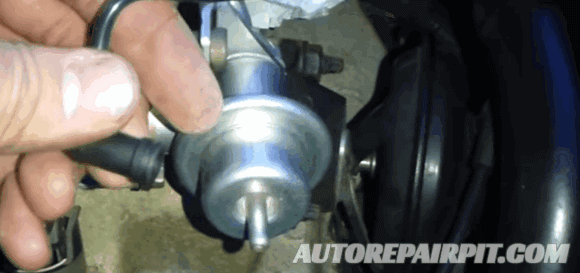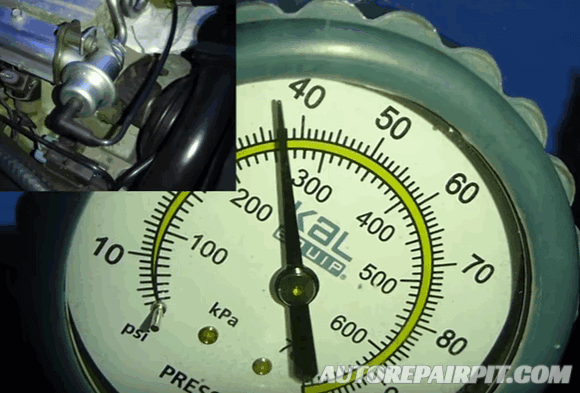To read Diagnose Fuel Pump (Part 1), click here.
Residual Fuel Pressure Test
For a period time (several minutes) residual pressure will be held by a system when the pump is stop running or turned off. Check the manual how much allowed pressure drop on this given period of time. When pressure drops so quickly, there a leaky fuel pressure regulator on vehicle, leaky fuel line, one or more fuel injectors leaks, or a leaky fuel pump check valve. On hot weather, vapor lock and hard starting may occurs caused by low residual fuel pressure.
Static Fuel Pressure Test
Fuel pressure must come up quickly and hold steady at a fixed value when the ignition is on, and the engine is off (or with a fuel pump energized). Compare the specifications with the pressure reading results. Check for voltage at the pump if there no pressure reading. If the pump is not running but the voltage is there, surely a bad fuel pump is the problem.

If the pressure reading result is lower than normal, the cause can be a faulty pressure regulator, filter or tank inlet sock, a blockage in the fuel line, or weak pump. To build up normal pressure the pump need to spinning fast enough, so if there a low voltage, it can prevent the pump spinning fast. Make sure to check the pump voltage. If there no problem with pump voltage, do not rush to judge the pump as the source of trouble, check also the operation of fuel pressure regulator and fuel filters and lines for obstructions.
Dead Head Pressure
The fuel pump pressure maximum output can be checked by this test. While idle, the pump must produce twice the normal operating pressure when the return line pinched shut. With higher engine speed, the pump may not be able to supply enough fuel if the pressure rating doesn’t go up with a return line blocked. The possibility that could cause is a inlet sock in the tank or plugged fuel filter, an almost empty fuel tank or obstructed fuel line, low voltage at the pump, or a worn pump.
Running Fuel Pressure Test
Compare the specifications with the gauge reading result while engine idling. The vehicle manufacturer provides a recommended range of acceptable pressure, ensuring fuel pressure is within that range. The problem caused the pressure low can be a clogged fuel filter, nearly empty fuel tank, a weak pump, a bad fuel pressure regulator, or inlet sock or line inside the fuel tank.
Fuel Volume Test
Driveability problems may still occurs even normal pressure delivered by the fuel pump, it happen if the fuel pump is not deliver enough volume that meet the engine’s needs. To evaluate the pump’s condition you need do a fuel volume test.
Measurement of the volume of fuel delivered at specified intervals is the purpose of testing the fuel volume test measures. You can do the test by connecting the fuel supply line with a fuel flow gauge, or connecting a hose from the regulator to a large container and disconnecting the fuel pressure regulator from the fuel return line.
CAUTION: While doing the test, make sure NO FLAMES or NO OPEN SPARKS nearby.
Energize the pump and during the specified interval of time, measure the volume of fuel delivered while the engine off. 3/4 to one quart of fuel in 30 seconds is the good output the pump should be deliver the fuel.
Some cause the delivery of fuel volume is low: obstructed fuel line or nearly empty tank, a inlet sock in the tank or a plugged fuel filter, or worn fuel pump. Remember if the pump that not enough voltage won’t generate adequate fuel flow due the fuel pump is not running fast enough. Half a volt of normal system voltage is the required a pump’s supply voltage. Check the ground, relay and wiring connectors if voltage supply is low than should be.
Fuel Pressure Regulator Tests
To ensure changes in line pressure in response to a engine vacuum is the purpose of the test checking the operation of the fuel pressure regulator. To compensate for changes in engine load and to maintain the proper operating pressure behind the injectors, this test should be done. Disconnect the pressure regulator from the vacuum hose while engine running. With line disconnected like this, fuel system pressure should increase 8 to 10 psi. If nothing happen, this indicated a plugged or leaky vacuum line or a faulty pressure regulator.
Any fuel that is being sucked into the hose will leave an indication of wetness inside the hose, so when the regulator is not connected to the vacuum hose, check any wetness inside the hose. There should no wetness inside the hose. Check the leak a diaphragm inside the regulator if you found the wetness inside of the hose. Fuel pressure can drop because of this, and the air/fuel mixture will be disrupted, as fuel will be sucked into the intake manifold. Regulator need to replaced if the diaphragm is leaking.
Fuel Pressure Drop Test
When each injector is energized, static system fuel pressure drop can be measured by this test. Test result will indicate if the injectors are dirty, the injectors need to be replaced or cleaned depend on compare result the amount of pressure drop for each injector. To energize the injectors, “injector pulser” is required by this test.
The test can be done this way, for a few seconds energize the fuel pump or turn the key on, so that in the fuel system will be built static pressure. After that turn off the key, for the specified time pulse one injectors and the pressure drop for current injectors must be noted. Rebuild again the static pressure by turn the key on back. You may test for other remaining injectors by repeating the way as described.

Depending on application, injectors pressure drop should not produce more than 5 to 7 psi, it should about 1 to 3 psi pressure drop (minimum) when it has been pulsed 100 times for five milliseconds.
Between all the injectors must be 2 psi or less for the difference in pressure drop. If between the highest and lowest it read the difference is 3psi, replace or cleaned the injectors because it dirty. When you energized the injector and there no pressure drop, you need to replace the injector because it clogged or defective. The injector will stick if the pressure gauge needles bounce off.
Repeat the test again after you clean the injectors. The pressure drop amount should show same result (the different must less than 2 psi) and at 100 pulses 5 milliseconds should no more than 7 psi. Injectors needs to be replaced if the re-test give an result the drop exceeds these limits or there no change on readings result.
Continue to Diagnose Fuel Pump (Part 3): Fuel System Scan Tool
